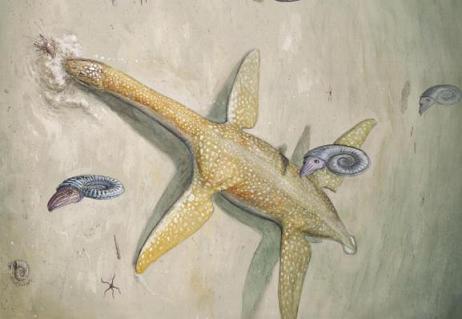A joint team of German and Swedish researchers has identified a new species of a giant sea monster that existed on Earth about 190 million years ago. The new findings, according to experts, will improve human understanding about how ‘super predators’ might have evolved in the Jurassic period.
In the 1980s, archeologists had recovered fossilized bones of a long-necked marine reptile, dubbed Arminisaurus schuberti, from a mine. The bones of this creature were damaged by mining machinery, but still researchers were able to recover about 40 percent of the skeleton. The skull, limb bones and vertebrae of this animal were intact enabling researchers to study this animal in detail. This animal has now been classified as an early relative of later Jurassic plesiosaur super predators known as pliosaurids that ruled the oceans during the Jurassic period.
“We describe a new plesiosaurian from the upper Pliensbachian Amaltheenton Formation of Bielefeld in northwestern Germany,” the researchers explain in their paper.
“The taxon is based upon an incomplete associated skeleton comprising part of the right mandibular ramus, several teeth, a series of cervical, pectoral, dorsal and caudal vertebrae, as well as ribs, limb girdle elements including a nearly complete right scapula, and various distal limb bones.”
Sven Sachs, a researcher at the Naturkunde-Museum Bielefeld in Germany said in a press release that “plesiosaurs were amongst the most successful marine predators from the Age of Dinosaurs.”
“Some, such as the famous Liopleurodon, were colossal predators up to 15 meters long. They were the equivalent of White sharks and Killer whales in the oceans today,” Sachs added.
However, Arminisaurus was much smaller, just 3–4 meters long. They most likely survived on squid, fish, and other small prey in the seas. These marine reptiles were characterized by a long neck.
According to researchers, this new species Arminisaurus schuberti has been named after Arminius, a Germanic tribal chief who led his men to victory over the Roman legions at the Battle of the Teutoburg Forest in 9 A.D.
“Arminisaurus is significant because it dates from a time frame early in the Jurassic, during which we have very few identifiable plesiosaur fossils,” said Benjamin Kear, Curator at Uppsala University in Sweden.
“Only two other plesiosaur fossils have ever been named from this mysterious interval in plesiosaurian evolution, making Arminisaurus a very important new addition for the global record of the group,” Kear said.
This study also suggested that Arminisaurus shared some of their features with plesiosaurs that lived 50 million years later, during the Cretaceous period.
The detailed findings of the study have been published in the Alcheringa, an Australasian Journal of Paleontology.
